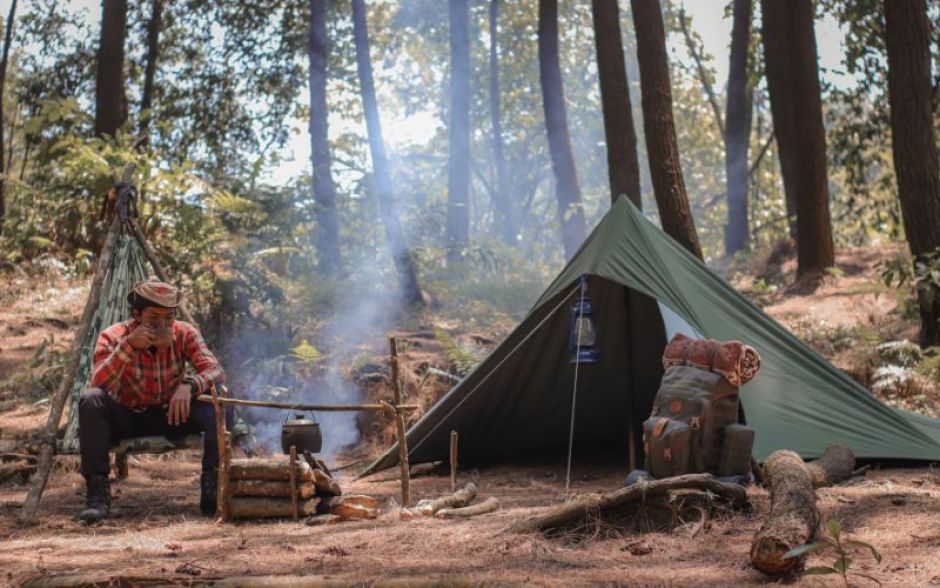
Tents : The Sheltering Haven in the Heart of Nature a Super Guide 2023
Every trekker understands the allure of the wilderness—the pristine landscapes, the challenging trails, and the unparalleled sense of freedom. But as night falls, and the temperature drops, there’s one piece of equipment that becomes an absolute necessity: the tent. More than just a temporary shelter, tents represent safety, comfort, and a momentary home amidst the unpredictable embrace of nature. As we embark on this exploration of tents, we’ll uncover their significance in the realm of trekking essentials and guide you through the vast array of options available to modern adventurers.

Table of Contents
The Fundamentals: Anatomy of a Tent
When you look at a tent, it might seem like a simple structure, but delve a little deeper, and you’ll discover an intricate design, each part serving a specific function to ensure a comfortable and safe outdoor experience. Understanding the anatomy of a tent is essential for every trekker and camper, whether you’re a novice setting up your first shelter or an experienced outdoorsman fine-tuning your gear.

1. Tent Body: The primary fabric component, the tent body is often made of breathable materials like nylon or polyester. This helps in minimizing condensation inside the tent while providing some degree of insulation. Many tent bodies also incorporate mesh panels for ventilation, especially useful in warmer climates.
2. Rainfly: Acting as the tent’s shield against rain, snow, and sometimes even UV rays, the rainfly is a waterproof layer that sits over the tent body. Some are full-coverage, offering protection from all sides, while others might only cover the tent’s top.
3. Groundsheet or Tent Footprint: Positioned beneath the tent, this waterproof layer provides a barrier between the tent floor and the ground. It prevents moisture seepage, protects the tent from sharp objects, and extends the tent floor’s lifespan.
4. Poles: The tent’s skeleton, poles provide the structure and stability. They can be made of various materials like aluminum, fiberglass, or carbon fiber. Some tents have poles that are color-coded or linked together for easier setup.
5. Stakes and Guy Lines: Stakes anchor the tent to the ground, ensuring it doesn’t get blown away by strong winds. Guy lines, on the other hand, are tensioned cords that pull the tent’s body and rainfly taut, enhancing its stability and shape.
6. Tent Doors and Zippers: The entrance and exit points, tent doors need to be robust and weatherproof. Quality zippers are crucial to ensure ease of use and durability. Some tents might offer multiple doors for convenience, reducing the need to clamber over fellow campers during nighttime exits.
7. Vestibules: These are extended portions outside the tent doors, provided by the rainfly. Vestibules offer additional storage space for gear, protecting it from rain and dew. They also act as a transition zone, helping to keep the tent’s interior clean by allowing campers to remove dirty footwear before entering.
8. Ventilation Points: To prevent condensation buildup inside the tent, especially during colder nights, ventilation points or vents are integrated into the design. These are usually mesh panels that can be opened or closed as needed.
9. Interior Pockets and Loops: Found inside the tent, these are for organization and convenience. Pockets can hold small essentials like torches, glasses, or phones, while loops might be used to hang lanterns or clotheslines.
10. Guyout Points: These are reinforced loops or patches on the tent body and rainfly where guy lines can be attached. They provide additional tie-down points, especially useful during heavy winds or storms.
In summary, the anatomy of a tent is a combination of function and innovation. As you become familiar with each part and its purpose, you’ll not only improve your tent-setting skills but also appreciate the craftsmanship and design thought that goes into creating these portable homes. The next time you’re out in the wild, remember each component’s role in ensuring your shelter stands strong, keeping you safe and cozy amidst nature’s unpredictability.
Tents Through the Ages: A Historical Perspective
The concept of portable shelter has been intertwined with the very narrative of human civilization. Since the dawn of time, tents have been emblematic of humanity’s innate wanderlust, our need to explore, and the compulsion to find shelter wherever the journey takes us.
Ancient Beginnings
The earliest tents were probably improvised shelters made from large animal skins draped over tree branches. Nomadic tribes in the plains of Asia and Africa primarily relied on such tents, made of hides and sometimes felt, for their portable and lightweight nature. These structures not only provided refuge from the elements but also became symbols of cultural identity for these communities.

Classical Civilizations
With the emergence of great ancient civilizations, tents took on more than just functional roles. The Roman Legions, for instance, used leather and canvas tents in their expansive campaigns. Pharaohs and monarchs of old reveled in grand tents during ceremonial occasions, showcasing intricate designs, rich fabrics, and ornate decorations, emphasizing their prestige and power.
Medieval Times to the Age of Exploration
In medieval Europe, tents became pivotal during military campaigns. Knights and monarchs used them, and their size and design were often indicative of rank and status. Larger tents served as command centers, places of gathering, or even makeshift chapels.

As the age of exploration dawned, tents became indispensable for explorers trekking through unknown lands. The design started evolving, focusing more on protection from varied climates and terrains.
Modern Era and Beyond
With the advent of the 20th century, technological innovations revolutionized tent materials and designs. The two World Wars saw the mass production of military tents, some of which influenced modern recreational designs.
The post-war era saw a rise in recreational camping, leading to a demand for lightweight, easy-to-set-up tents. Advancements in synthetic materials, such as nylon and polyester, offered tents that were both durable and resistant to various weather conditions.

Today, the continuous quest for lighter and more durable tents has led to innovations like the geodesic design and air-beam supported tents. Tents are no longer just about shelter; they are about challenging the extremes, ensuring sustainability, and merging the age-old nomadic charm with cutting-edge technology.
In conclusion, tents have journeyed with us, echoing our civilizations, our challenges, and our innovations. From humble animal hides to sophisticated modern designs, they remain steadfast symbols of our innate desire to explore, adapt, and survive.
Selecting Your Tent: Factors to Consider
- Trek Duration:
- Short trips: Basic, lightweight tents.
- Extended expeditions: Sturdier, more feature-rich tents.
- Weather Conditions:
- Summer tents: Ventilated and lightweight.
- 3-Season tents: Suitable for spring, summer, and fall; equipped to handle rain and light snow.
- 4-Season tents: Designed for harsh conditions, including heavy snow and strong winds.
- Capacity:
- Single-person tents: Compact and lightweight.
- Multi-person tents: Spacious, with provisions for added storage.
- Weight & Portability:
- Ultralight tents: Ideal for long-distance treks.
- Standard tents: Offer a balance between weight and comfort.
Tent Innovations: Pioneering Features to Look For
- Air Vents: Reduces condensation, ensuring the interior remains dry.
- Storage Options: Lofts, pockets, and vestibules for storing gear.
- Easy Setup: Color-coded poles and clips for swift assembly.
- Durability Enhancements: Reinforced seams, zippers, and UV resistant materials.
Caring for Your Tent: Maintenance Tips
- Always dry your tent before storage to prevent mold.
- Clean the tent with mild soap, avoiding harsh detergents.
- Regularly check poles and zippers for signs of wear.
- Use a groundsheet to minimize direct contact with the ground.
Conclusion:
In the grand theatre of trekking, tents play an indispensable role, acting as the silent guardians that provide trekkers with a reliable refuge amidst the vast expanse of the great outdoors. Ensuring safety and offering comfort across diverse terrains and unpredictable weather patterns, tents are the unsung heroes of countless adventures.
As we navigate between the cherished wisdom of age-old camping practices and the dawn of cutting-edge shelter technologies, today’s explorer is presented with an extensive spectrum of choices. With each tent design being an embodiment of a unique story and purpose, the significance of making an informed decision becomes paramount.
The tent you select is not just a mere piece of equipment; it’s a testament to your journey, your haven in the heart of nature, a protective embrace against the sometimes harsh, sometimes gentle whims of the wild. It stands as a symbol of your bond with nature, representing a place of rest, reflection, and rejuvenation.
So, as you meticulously curate your trekking essentials, let the tent be a reflection of your trekking spirit and aspirations. Choose it not just for its material quality, but for the memories it promises to shelter. Treat it with respect, and in return, it promises to be your steadfast companion, accompanying you through serene valleys, over towering mountains, and into the very soul of the wilderness.
You might also like:
Sharing would be nice:
Other Trekking Essentials:
Newsletter
About me
Meet Dennis, an enthusiast of the great outdoors. For the past 15 years, he’s maintained a daily routine that includes running, hiking, and hitting the gym, embodying a commitment to an active and healthy lifestyle.
Dennis is a true advocate for the joy and rejuvenation that outdoor living can bring.



